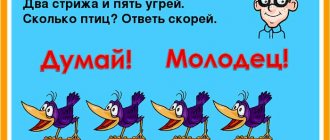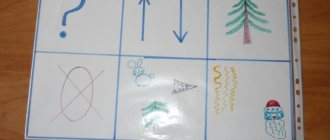What is the grammatical structure of speech
The grammatical structure of speech is the correct construction of speech (texts, sentences, dialogues).
The formation of grammatical structure occurs gradually. At first, children do not use prepositions in their speech, they may confuse the gender of the noun and place emphasis incorrectly. In the process of ontogenesis and normal speech development, vocabulary is enriched, new knowledge is acquired about the world around us, and sentences take on the correct form.
Therefore, teachers of preschool educational institutions are faced with the task of improving the grammatical structure of speech. More precisely, to help children understand the morphology, syntax and word formation of their native language.
How to form a grammatical structure of speech in preschoolers
The formation of the grammatical structure of speech in preschoolers is carried out according to several tasks:
- Formation of sentence structure. This task can be easily implemented based on the plots of various fairy tales. First, the teacher offers a fairy tale, and then the children try to compose a short retelling with the help of the teacher. The visual element of the work is also used - making sentences based on the plot depicted in the picture.
- Development of word formation. Word formation is a component of the grammatical aspect of speech that causes the greatest difficulties among preschoolers. Didactic games prove good effectiveness in this area. For example, exercise “Pets”. Children are invited to play and tell the composition of a family of domestic animals, what the cubs are called, and how they are useful in the household. Interesting tasks for this stage are those where you need to name a part or element of the whole.
- Development of coherent speech. In this task, the main activity is a role-playing game. Children need communication and building dialogue relationships. In such activities, children independently learn new techniques and means of communication.
Note! Thus, for the qualitative development of the grammatical structure of speech in children, communication with adults and peers is necessary. With the constant interaction of children with each other, non-forced and gentle development occurs.
Methods and techniques for developing grammatically correct speech in preschoolers
15
Ministry of Education and Science of the Arkhangelsk Region
GBPOU JSC "Kargopol Pedagogical College"
Essay
Methods and techniques for developing grammatically correct speech in preschoolers
Work completed:
Nikulina Anna Andreevna
Specialty: 02/44/01
Kargopol - 2016
Introduction
Speech is the most important creative mental function of a person, the area of manifestation of the inherent ability of all people for cognition, self-organization, self-development, for building one’s personality, one’s inner world through dialogue with other individuals, other worlds, other cultures [2 p.3].
The child learns the grammatical structure of the language in the process of communicating with adults and peers. Children borrow words in different grammatical forms from the speech of people around them and gradually begin to independently use a variety of grammatical means. However, the process of mastering the grammatical structure of speech is complex and lengthy. While mastering the existing norms and rules of the language, the child makes numerous grammatical errors in his work. Therefore, the system of speech work with preschool children includes work on the formation of grammatically correct speech [4 p.10].
Preschool age is a period of active acquisition by a child of spoken language, the formation and development of all aspects of speech: phonetic, lexical, and grammatical. Full command of the native language in preschool childhood is a necessary condition for solving the problems of mental, aesthetic and moral education of children.
The development of speech is closely related to the development of a child’s thinking. Mastering grammatically correct speech enables children to freely reason, ask, draw conclusions, and reflect various connections between objects and phenomena. It follows from this that in preschool age a child needs to develop the habit of speaking grammatically correctly. There are various methods and techniques with the help of which a child develops grammatically correct speech.
Objectives and content of work on the formation of the grammatical structure of speech
The term “grammar” is used in linguistics in two meanings: it means, firstly, the grammatical structure of a language, and secondly, the science, a set of rules about changing words and their combination in a sentence. The method of speech development examines the issues of children’s mastery of the grammatical structure of the language in speech practice [3 p. 111].
When forming a child’s grammatically correct speech, one should distinguish between working on its morphological and syntactic aspects. Morphology studies the grammatical properties of a word, its form, syntax - phrases and sentences [3 p.111].
According to K.D. Ushinsky, grammar is the logic of language. Each form in grammar expresses some general meaning. By abstracting from the specific meanings of words and sentences, grammar gains greater abstracting power and the ability to typify the phenomena of language. Children who learn grammar purely practically also develop their thinking. This is the greatest importance of grammar in the development of a child’s speech and psyche.
The tasks of forming the grammatical structure of speech are considered in three directions:
- To help children practically master the morphological system of their native language (variation by gender, number, person, tense).
- Help children master the syntactic side: teach the correct agreement of words in a sentence, constructing different types of sentences and combining them in a coherent text.
- Provide knowledge about some norms for the formation of word forms - word formation [1 chapter 5 par. 3].
The scope of grammatical generalization skills can be represented as follows.
In morphology.
The morphological structure of preschool children's speech includes almost all grammatical forms. The largest place is occupied by nouns and verbs.
Nouns denote objects, things, people, animals, and abstract properties. They have the grammatical categories of gender, number and case (they differ in gender and vary in number and case).
It is necessary to train children in the correct use of case forms (especially in the use of the genitive plural form: plums, oranges, pencils).
In a sentence, the noun is one of the most important components; it agrees with adjectives in gender, number and case, and coordinates with the verb. Children should be shown a variety of ways to agree nouns with adjectives and verbs.
A verb denotes the action or state of an object. Verbs differ in appearance (perfect and imperfect), change in person, number, tense, gender and mood.
Children must correctly use verbs in the form of the 1st, 2nd, 3rd person singular and plural (I want, you want, you want, we want, they want).
Preschoolers must correctly use the category of gender, correlating the action and object of the feminine, masculine or neuter gender with past tense verbs (the girl said; the boy read; the sun was shining).
The explanatory mood of the verb is expressed in the form of present, past and future tenses (he plays, played, will play). Children are led to the formation of the imperative mood of the verb (an action to which someone encourages someone: go, run, let's go, run, let him run, let's go) and to the formation of the subjunctive mood (possible or intended action: would play, would read) .
Children need mastery of different categories and forms of verbs to construct different types of sentences.
An adjective denotes a characteristic of an object and expresses this meaning in the grammatical categories of gender, number, and case.
Children are introduced to the agreement of noun and adjective in gender, number, case, with full and short adjectives (cheerful, cheerful, cheerful), with degrees of comparison of adjectives (kind - kinder, quiet - quieter).
In the learning process, children master the ability to use other parts of speech: pronouns, adverbs, conjunctions, prepositions.
In word formation.
Children are led to the formation of one word on the basis of another cognate word with which it is motivated, i.e. from which it is derived in meaning and form. Words are formed using affixes (endings, prefixes, suffixes).
The methods of word formation in the Russian language are diverse: suffixal (teach - teacher), prefixal (write - rewrite), mixed (feast, scatter).
Children can, starting from the original word, select a word-forming nest (snow - snowflake, snowy, snowman, snowdrop).
Mastering different methods of word formation helps preschoolers correctly use the names of baby animals (bare, fox), tableware (sugar bowl, candy bowl), directions of movement (rode - went - left).
In syntax.
Children are taught ways to combine words into phrases and sentences of different types - simple and complex. Depending on the purpose of the message, sentences are divided into narrative, interrogative and incentive. A special emotional coloring, expressed by a special intonation, can make any sentence exclamatory.
It is necessary to teach children the ability to think about word combinations, then correctly link words into sentences [1 chapter 5 par. 3].
The development of the grammatical structure of speech is the key to successful general speech training, which ensures practical mastery of the phonetic, morphological and lexical levels of the language system. The formation of grammatical skills has a positive effect on the increase in children’s volitional factor in statements, creates the prerequisites for the emergence of the planning function of speech, for the introduction of the concept of norm (“possible”, “impossible”, “right”, “wrong”). A child who has developed the grammatical structure of speech is emotionally healthy: he is not constrained in communicating with peers, is not shy, and is not fearful in speech statements, in expressing his own thoughts, feelings, and moods; he painlessly enters the school team, feels like a full and equal participant in collective activities [5 p.98].
Methods and techniques for developing grammatically correct speech in preschoolers
The formation of grammatically correct speech is carried out in two ways: in teaching in the classroom and in developing grammatical skills in everyday communication. Classes make it possible to prevent children’s grammatical mistakes, and in everyday life conditions are created for the practice of verbal communication [1 chapter 5 par. 3].
The main means of forming grammatically correct speech is training, which is carried out in special classes. In any lesson, the teacher must correct errors in children’s speech. Of particular importance are classes where special work is carried out to prevent negative qualities of speech.
In such classes, all the children’s attention is drawn only to the desired grammatical form. A word, its modification, phrase or sentence becomes the content of their mental work. The child begins to realize how to speak, strives to say it correctly, competently, beautifully. A comfortable, business-like atmosphere of the lesson ensures that children are not distracted, they hear everything from the teacher’s explanations and instructions, and consciously monitor the quality of their comrades’ speech [3 p. 118].
We can include among the methods: didactic games, dramatization games, verbal exercises, looking at pictures, retelling short stories and fairy tales. These methods can also act as techniques when using other methods.
With children of younger and middle age, the following are conducted to develop grammatically correct speech: didactic games and dramatization games. The exercise method is used with children of senior preschool age.
Didactic games are an effective means of consolidating grammatical skills, since thanks to the dynamism, emotionality and interest of children, they make it possible to practice the child many times in repeating the necessary word forms. Didactic games can be carried out both with toys, objects and pictures, and without visual material - in the form of verbal games built on the words and actions of the players.
In each didactic game, the program content is clearly defined. For example, in the game “Who Left and Who Came,” the correct use of the names of animals and their cubs in the nominative singular and plural is reinforced. In accordance with the didactic task (program content), toys are selected with which you can easily perform various actions, forming the desired grammatical form [1 chapter 5 par. 4].
There are mandatory requirements for visual material.
- It should be familiar to children;
- The material is designed aesthetically;
- Evoke specific images;
- Encourage thinking.
Before playing, toys are examined, children's vocabulary is activated by the names of color, shape, purpose of toys, and actions that can be performed with them.
Dramatization games are distinguished by the fact that they play out scenes (mini-performances) with toys. At first the teacher himself is the director, later the child becomes the director. Games of this kind provide an opportunity to reproduce certain life situations in which children practice using prepositions, changing verbs, and agreeing nouns with adjectives. The basic pedagogical requirements for this method are similar to those for didactic games.
Special exercises are aimed at developing grammatical skills in the areas of morphology, syntax and word formation. K. D. Ushinsky attached great importance to logical exercises in school teaching. He rightly believed that exercises most prepare a child for learning grammar.
K. D. Ushinsky developed examples of such exercises for “initial teaching of the native language.” E. I. Tikheyeva developed exercises for the development of speech of preschoolers, including for the development of its syntactic side: for the spread of sentences, for adding subordinate clauses, etc.
Modern methodological and educational manuals offer grammar exercises for all age groups.
Examination of paintings, mainly plot ones, is used to develop the ability to construct simple and complex sentences.
Retelling short stories and fairy tales is a valuable tool for teaching children how to construct sentences, since the work of fiction itself is an example of grammatically correct speech. Classes to teach children retelling enrich the language, develop consistency and logic in thinking and speech.
Methodological techniques are varied, they are determined by the content of the lesson, the degree of novelty of the material, the speech characteristics of children, and their age.
The leading methods of teaching grammatical skills can be called example, explanation, indication, comparison, repetition. They prevent children from making mistakes and help focus the child’s attention on the correct form of a word or sentence structure.
The teacher’s model of correct speech plays an important role in the initial stages of education. Children are offered to learn to say words correctly and remember them:
· go - come, wave - wave, look - look;
· take off (what?) – the coat, but undress (who?) – the doll;
· put on (what?) – a hat, but dress (who?) – a boy.
An explanation of how to use difficult forms. For example: all words change, but there are words like coat, cinema, coffee, cocoa, metro, radio, which never change, so you need to say: one coat, there are many coats on the hanger, there is a fur collar on the coat. These words must be remembered.
Comparison of two shapes (stockings - sock; pencils - oranges - pears; tables - windows). To firmly memorize a difficult form, children repeat it many times after the teacher, together with him, in choir and one at a time.
Techniques such as creating problematic situations are also used; hint of the required form; bug fix; questions of a prompting and evaluative nature; involving children in correcting mistakes; reminder of how to say correctly, etc.
It is important that grammatical forms are mastered in live speech and become familiar. It is necessary to cultivate in a child a linguistic sense, an attentive attitude to language, and the ability to “feel” an error not only in someone else’s speech, but also in his own speech. Independent correction of one’s own mistakes is an indicator of a sufficiently high level of mastery of the grammatical side of the language and awareness of the phenomena of language and speech.
During classes, the teacher achieves the activity of all children, the accuracy and awareness of their answers, fixes their attention on the sound image of the word and especially on the pronunciation of endings.
The practice of verbal communication is the most important condition for the formation of grammatical skills.
Everyday life makes it possible to discreetly, in a natural setting, to train children in the use of the necessary grammatical forms, to record typical mistakes, and to give examples of correct speech.
Mastery of the grammatical structure of a language depends not only on verbal communication with others and on imitation of the speech of adults, but also on the perception of the surrounding reality, on the direct practical activities and needs of the child. He develops a speech stereotype only if words and their forms are connected with the facts of reality. Therefore, it is so important to organize children’s activities with objects, familiarization with their properties and qualities, and observations of natural phenomena. The child’s establishment and awareness of the connections and dependencies that exist in nature are reflected in an increase in the volume of sentences, in the construction of complex speech structures, in the use of conjunctions: so that, since, therefore [1 chapter 5 par. 4].
Correcting grammatical errors.
The authors of some manuals understand the formation of grammatical skills in everyday communication mainly as correction of errors. We cannot agree with this, since error correction is carried out in all classes (and not only in speech development), as well as outside them, and the tasks and content of everyday speech communication are much broader.
The error correction technique has been sufficiently developed by O. I. Solovyova and A. M. Borodich. Its main provisions can be formulated as follows:
- Correcting errors helps children become more aware of language norms, i.e. distinguish how to speak correctly.
- An uncorrected grammatical error is an unnecessary reinforcement of incorrect conditional connections both for the child who speaks and for those children who hear him.
- Do not repeat the incorrect form after the child, but invite him to think about how to say it correctly. You need to immediately give the child a sample of correct speech and offer to repeat it.
- Mistakes should be corrected tactfully and kindly.
- With young children, correcting grammatical errors consists mainly in the fact that the teacher, correcting the error, formulates the phrase or phrase in a different way. For example, a child said: “We put a plate and a lot of spoons and cups on the table.” - “That’s right, you set the table well for tea, put a lot of spoons and put a lot of cups.”
- Older children should be taught to hear mistakes and correct them themselves.
- An example of the correct speech of one of the children is used as a sample.
- When correcting children's mistakes, you should not be too intrusive; you must take into account the situation and be an attentive and sensitive interlocutor.
Thus, the learning process should be organized so that from the very beginning mastery of the grammatical structure of the language is creative in nature. Classes on the formation of grammatically correct speech in all age groups are in the nature of didactic games and exercises with and without visual material. Games and exercises take 5-10 minutes, i.e. they constitute only part of the lesson. Active teaching techniques are sample, explanation, repetition, comparison, as well as correction and prompting [6 p. 107].
Conclusion
The formed grammatical structure of speech is an indispensable condition for the successful and timely development of monologue speech - one of the leading types of speech activity. Any type of monologue (narration, description, etc.) requires mastery of logical connection techniques of all types of simple and complex sentences. The development of the grammatical structure of speech is the key to successful general speech training, which ensures practical mastery of the phonetic, morphological and lexical levels of the language system. The formation of grammatical skills has a positive effect on the increase in children’s volitional factor in statements and creates the prerequisites for the emergence of the planning function of speech.
The learning process is organized so that, from the very beginning, mastery of the grammatical structure of a language is of a creative nature, based on the child’s indicative (search) activity in the world around him and in words, on linguistic generalizations, and experimentation with words. Classes on the formation of grammatically correct speech in all age groups are in the nature of didactic games and exercises with and without visual material. Games and exercises are only part of the lesson. Active teaching techniques are example, explanation, repetition, comparison, as well as correction and prompting.
List of information sources
- Alekseeva, M.M. Methods of speech development and teaching the native language of preschoolers / M.M. Alekseeva, V.I. Yashina. - M.: Publishing House, 2000. - 400 p.
- Arushanova, A.G. Speech and verbal communication of children: Formation of the grammatical structure of speech: a methodological manual for educators / A.G. Arushanova. – M.: Mosaic – Synthesis, 2005. – 296 p.
- Borodich, A.M. Methods for developing children's speech/A.M. Borodich. – M.: Education, 1981. – 255 p.
- Gerbova, V.V. Speech development in kindergarten. Middle group/ V.V. Gerbova. – M.: Mosaic – Synthesis, 2014. – 80 p.
- Starodubova, N.A. Theory and methods of speech development for preschoolers / N.A. Starodubova. – M., 2008.
Word formation as a component of the grammatical aspect of speech
The word formation process, the formation of one word on the basis of another, is a rather complex process. It happens in several stages:
- first period (from 2.5 to 4 years). Words are formed accidentally, involuntarily;
- the second period (from 4 to 6 years), when there is an active accumulation of vocabulary and, at the same time, word production;
- the third period is the assimilation of rules and norms of speech.
Articulatory gymnastics for sounds “s, z, c”
Important! The active period of the word formation process is the age from 4 to 6 years and it is necessary not to miss this sensitive period. Underdevelopment of one of the stages leads to a decrease in the educational opportunities of the other. ONR is detected already in the early stages of development.
Factors influencing the development of grammatical structure of speech
Among the factors that influence the development of speech in preschool children, educational psychologists identify social and genetic factors.
- Social factors. Family plays an important role in social factors. In a complete family, children do not experience a lack of communication and constantly practice their speech needs. If a child is raised by a single parent, the possibility of communication is significantly reduced. The number of children plays an important role. Communicating with brothers and sisters at home, children can realize their interests in active and role-playing games. But at the same time, as psychologists note, families with many children devote slightly less time to reading than families with one or two children.
An important point in the development of speech remains the material resource of the family and the level of education of the parents. Fathers and mothers of high socioeconomic status have children with larger vocabularies as a result of parents' own use of grammatically correct sentences. Such parents can allow children to receive more information about the world around them, enriching and organizing the subject environment. Moreover, in families where a warm atmosphere and mutual understanding prevail, the child’s vocabulary takes on a more emotional character.
By attending a preschool educational institution, preschoolers expand their range of communications and gain positive communication experiences.
- Genetic factors. The successful development of parents has a beneficial effect on the development of speech skills in children. The level of intellectual development and the ability to successfully learn is inherited. Children whose mothers and fathers did well in school and have higher education learn basic grammatical principles of speech a little faster.
Didactic games for the assimilation of animation and inanimateness
Didactic games are supplemented with games for mastering the category of animate-inanimate (“What (who) do we see?”, the imperative mood of the verb (“Bear, do it!”). Verbal exercises are introduced to consolidate the category of gender in nouns, agreeing adjectives with nouns, and using indeclinable names nouns, mixed verbs (to want and to run). For example: Big boy. How can you say about a girl? What is she like? What (who else) can you say big? Big? Big?
At senior preschool age, the assimilation of the native language system is completed. By the age of six, children learn the basic patterns of changing and combining words into sentences, agreement in gender, number and case. Only atypical forms cause difficulty. Children sometimes encounter errors in the alternation of consonants (“I AM vengeance and my vengeance is terrible”, in the use of nouns in the genitive case in the plural (“Don’t scare the ALIENS”, in the formation of the imperative mood of verbs (GO, LYE, LIE, STERI, TERI) and the comparative degree of the adjective and adverb (“This road is SHORTER”, “I WIPED my face DRY.”) Difficulties for the child are the combination of nouns with numerals (WITH TWO children, pronouns (THEIR yard, the use of participles (BROKEN, DRAWN, verbs want, run , call (THEY ARE RUNNING, HE WANTS, THEY CALL YOU).
The acquisition of grammar at this age is facilitated by the development of elements of logical, abstract thinking, and the formation of linguistic generalizations.
The tasks of this age stage are: to teach children to correctly change all the words in their active vocabulary, to cultivate in the child a critical attitude towards grammatical errors in his own and others’ speech, and the need to speak correctly. The role of didactic games with toys is reduced, pictures, verbal didactic games and special verbal grammar exercises are used more.
The second direction of work is the formation of the syntactic side of speech.
When working on syntax, the task of developing skills in constructing different types of sentences and the ability to combine them into a coherent statement comes to the fore.
As already indicated, the speech of 3-year-old children is situational, so it is necessary to teach the child to construct phrases from two or three words (simple sentences). In the fourth year of life, the ability to construct sentences of different types - simple and complex - develops. For this purpose, pictures, communicative situations, didactic games, and dramatization games are used.
In early preschool age, work on sentences takes place in the following sequence: first, children are taught to feel the basis of a sentence (subject and predicate), then distribute and grammatically formulate a simple sentence.




